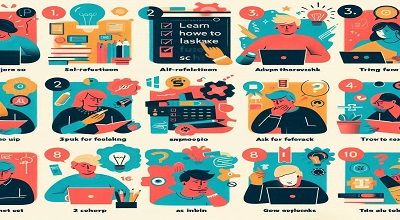Help Students Learn Through Their Mistakes
Helping students learn through their mistakes is an important aspect of effective teaching. Here are 10 ways to support students in turning their mistakes into valuable learning opportunities:
Create a Positive Learning Environment:
Foster a classroom culture that encourages risk-taking and embraces the idea that making mistakes is a natural part of the learning process. Make it clear that everyone is on a learning journey, and mistakes are growth opportunities.
Normalize Mistakes:
Emphasize that making mistakes is normal and part of the learning process. Share stories of successful individuals who faced setbacks and challenges on their path to success. This helps students understand that mistakes are not failures but stepping stones to improvement.
Provide Constructive Feedback:
Offer feedback that is specific, timely, and constructive. Instead of merely pointing out errors, guide students on how to correct them. Focus on the process of improvement rather than just the final result.
Encourage Self-Reflection:
Teach students to reflect on their mistakes. Ask them questions such as, “What went wrong?” and “How could you approach this differently next time?” This helps them develop a deeper understanding of their errors and how to avoid similar pitfalls in the future.
Implement Formative Assessments:
Use formative assessments regularly to gauge students’ understanding and identify areas where they may be struggling. This allows you to address misconceptions and provide additional support before misunderstandings become ingrained.
Promote a Growth Mindset:
Foster a growth mindset by praising effort and perseverance rather than innate abilities. Reinforce the idea that intelligence can be developed through hard work and learning from mistakes. Encourage a positive attitude toward challenges.
Model Resilience:
Demonstrate resilience in your own learning experiences. Share stories of times when you faced challenges, made mistakes, and learned from them. Modeling resilience helps students see that setbacks are a natural part of the learning journey.
Use Peer Collaboration:
Encourage collaboration and peer-to-peer learning. Students can learn from each other’s mistakes and successes. This not only helps in understanding different perspectives but also creates a supportive learning community.
Set Realistic Expectations:
Ensure that your expectations are realistic and aligned with students’ developmental levels. Unrealistic expectations can lead to unnecessary pressure and fear of making mistakes. When students feel less anxious, they are more likely to take risks and learn from their errors.
Celebrate Improvement:
Acknowledge and celebrate the progress students make, especially when they learn from their mistakes. Recognize their effort and growth, reinforcing the idea that improvement is the goal rather than perfection.
By implementing these strategies, educators can create an environment where students feel comfortable making mistakes, learning from them, and ultimately becoming more resilient and effective learners.
